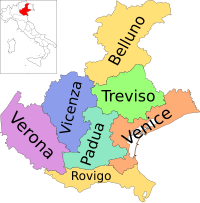Province of Treviso
Province of Treviso
Provincia di Treviso (Italian) | |
|---|---|
 Cathedral of Treviso | |
 Map highlighting the location of the province of Treviso in Italy | |
| Country | |
| Region | |
| Capital(s) | Treviso |
| Comuni | 95 |
| Government | |
| • President | Stefano Marcon (Lega Nord) |
| Area | |
• Total | 2,479.83 km2 (957.47 sq mi) |
| Population (30 June 2020) | |
• Total | 885,616 |
| • Density | 360/km2 (920/sq mi) |
| GDP | |
| • Total | €26.867 billion (2015) |
| • Per capita | €30,311 (2015) |
| Time zone | UTC+1 (CET) |
| • Summer (DST) | UTC+2 (CEST) |
| Postal code | 31100, 31010-31023, 31025-31040, 31043-31059 |
| Telephone prefix | 0421, 0422, 0423, 0438 |
| Vehicle registration | TV |
| ISTAT | 026 |
| Website | www |
The province of Treviso (Italian: provincia di Treviso) is a province in the Veneto region of Italy. Its capital is the city of Treviso. The province is surrounded by Belluno in the north, Vicenza in the west, Padua in southwest, Venice in the south-east and Friuli-Venezia Giulia in the east. The current President of Treviso is Stefano Marcon, elected in September 2016. He is also the current mayor of Castelfranco Veneto.
History
[edit]The province of Treviso was established by the Celts but later was flourished under the Romans, in which they had their own district when it became a Municipium, before it was subjugated to Hun, Ostrogoth, and Lombard control.[2] Over time, political power was replaced by ecclesiastical authority, and Treviso was divided into two dioceses around 1000 AD. It evolved into a county, municipality, and later a lordship. In the late 1300s, Treviso fell under the rule of the Republic of Venice and was divided into various regiments and feudal territories, yet it maintained its unity under the podestà of Treviso.[3]
During the 18th and 19th centuries, the region went through changes with the fall of Venice to France in 1797, then Austria,[3] and back to France again. It was finally organized into departments, districts, and municipalities under French and Austrian rule. After several transitions, the territory was reorganized, and in 1816, it became the new province of Treviso within the Kingdom of Lombardy–Venetia with ten districts. At the top of the government stood the provincial delegation, supported by the provincial congregation, with advisory functions. This situation was interrupted by the interlude of 1848 when the Republic of San Marco was established: during that brief period, a provisional central government was formed, along with a committee for each district. In 1853, there was a new reorganization of the system, with the abolition of the districts of Motta and Ceneda.[citation needed] This territorial organization remained largely unchanged until the 20th century.
Geography
[edit]The province is mostly flat, but it has hilly terrain in the northern region. Along the border with the province of Belluno, there are mountainous areas with peaks reaching over a thousand meters. Mount Grappa and Col Visentin are the highest peaks. Montello, an isolated hill on the right bank of the Piave River, is also noteworthy.
The province is rich in water resources, with numerous springs (known as "fontanassi") in the mid-low area. The Sile River, originating in Casacorba, flows through Treviso's historic center. The main river is the Piave, characterized by a wide gravel bed along most of its course. Other notable watercourses include the Livenza, Monticano, and Meschio, originating from the foothill area.
Economy
[edit]The province is home to the headquarters of clothing retailer Benetton, Sisley, Stefanel, Geox, Diadora and Lotto Sport Italia, appliance maker De'Longhi, and bicycle maker Pinarello. [4]
Comuni
[edit]There are 95 comuni (sg.: comune) in the province:[5]
References
[edit]- ^ Regions and Cities > Regional Statistics > Regional Economy > Regional Gross Domestic Product (Small regions TL3), OECD.Stats. Accessed on 16 November 2018.
- ^ Wilhelm, 596 (1881)
- ^ a b "History of Treviso".
- ^ L’economia nella provincia di Treviso tb.camcom.gov.it
- ^ "Comuni di Treviso". tuttitalia.it (in Italian).



